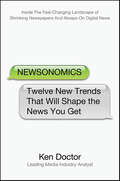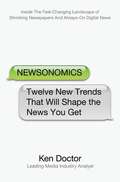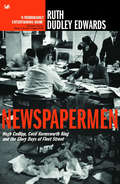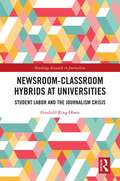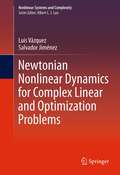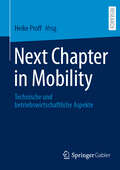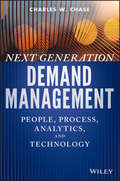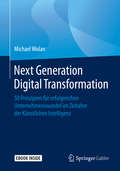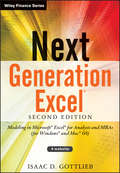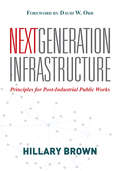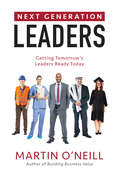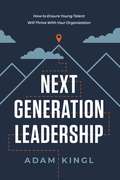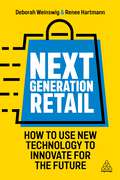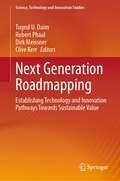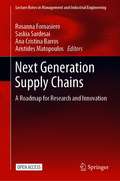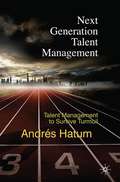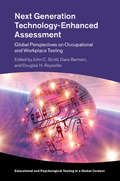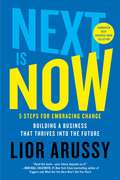- Table View
- List View
Newsletters and Press Releases: Bullet Guides
by Brian SalterOpen this book and you will- Get people's attention- Write compelling copy- Make an impact in the media- Keep your customers coming back
Newsonomics: Twelve New Trends That Will Shape the News You Get
by Ken DoctorThe New NewsReports of the death of the news media are highly premature, though you wouldn't know it from the media's own headlines. Ken Doctor goes far beyond those headlines, taking an authoritative look at the fast-emerging future.The Twelve Laws of Newsonomics reveal the kinds of news that readers will get and that journalists (and citizens) will produce as we enter the first truly digital news decade. A new Digital Dozen, global powerhouses from The New York Times, News Corp, and CNN to NBC, the BBC, and NPR will dominate news across the globe, Locally, a colorful assortment of emerging news players, from Boston to San Diego, are rewriting the rules of city reporting, Newsonomics provides a new sense of the news we'll get on paper, on screen, on the phone, by blog, by podcast, and via Facebook and Twitter. It also offers a new way to understand the why and how of the changes, and where the Googles, Yahoos and Microsofts fit in. Newsonomics pays special attention to media and journalism students in a chapter on the back-to-the-future skills they'll need, while marketing professionals get their own view of what the changes mean to them.
Newsonomics: Twelve New Trends that Will Shape the News You Get
by Ken DoctorThe New News: Reports of the death of the news media are highly premature, though you wouldn't know it from the media's own headlines. Ken Doctor goes far beyond those headlines, taking an authoritative look at the fast-emerging future. The Twelve Laws of Newsonomics reveal the kinds of news that readers will get and that journalists (and citizens) will produce as we enter the first truly digital news decade. A new Digital Dozen, global powerhouses from The New York Times, News Corp, and CNN to NBC, the BBC, and NPR will dominate news across the globe, Locally, a colorful assortment of emerging news players, from Boston to San Diego, are rewriting the rules of city reporting, Newsonomics provides a new sense of the news we'll get on paper, on screen, on the phone, by blog, by podcast, and via Facebook and Twitter. It also offers a new way to understand the why and how of the changes, and where the Googles, Yahoos and Microsofts fit in. Newsonomics pays special attention to media and journalism students in a chapter on the back-to-the-future skills they'll need, while marketing professionals get their own view of what the changes mean to them.
Newspapermen: Hugh Cudlipp, Cecil Harmsworth King and the Glory Days of Fleet Street
by Ruth Dudley EdwardsThey were 'Cudlipp' and 'Mr King' when they met in 1935. At 21, gregarious, extrovert and irreverent Hugh Cudlipp had many years of journalistic experience: at 34, shy, introspective and solemn Cecil Harmsworth King, haunted by the ghost of Uncle Alfred, Lord Northcliffe, the great press magnate, and bitter towards Uncle Harold, Lord Rothermere of the Daily Mail, was fighting his way up in the family business. Opposites in most respects, they were complementary in talents and had in common a deep concern for the underdog. Cudlipp, the journalistic genius, and King, the formidable intellect, were to become, in Cudlipp's words, 'the Barnum and Bailey' of Fleet Street. Together, on the foundation of the populist Daily Mirror, they created the biggest publishing empire in the world. Yet their relationship foundered sensationally in 1968, when - as King tried to topple the Prime Minister - Cudlipp toppled King. Through the story of two extraordinary men, Ruth Dudley Edwards gives us a riveting portrait of Fleet Street in its heyday.
Newsprint Industry
by Ramon Casadesus-Masanell Nabil Al-Najjar James PykeDescribes the 1990s consolidation on the newsprint industry. Questions whether consolidation will ever deliver on its promise. Whereas some industry observers maintain that the effects of consolidation are already visible, others argue that further consolidation is necessary. Others, however, claim that because newsprint is a commodity and firms compete on the basis of price, consolidation will not restore industry profitability. Data to build individual firm and industry supply curves for 2001 is available upon further request. Illustrates the transition from a perfectly competitive industry (demand and supply) to oligopolistic competition (Porter's five forces). To obtain further exhibits, please contact HBSP customer service for more information.
Newsroom-Classroom Hybrids at Universities: Student Labor and the Journalism Crisis (Routledge Research in Journalism)
by Gunhild Ring OlsenThis book investigates the success of U.S. nonprofit university centers, where students work alongside investigative reporters, from a professional and educational perspective. Drawing on a detailed investigation of four of the most prominent and renowned centers in the U.S. – the IRP Berkeley (UC Berkeley), the Stabile Center (Columbia University), the Workshop (American University), and the New England CIR (Boston University) – the newsroom role and the classroom role of university nonprofits is examined. Finding the description of a win-win situation – where overstretched newsrooms get extra resources; while students learn from the best – an oversimplification, the author explores learning outcomes, student experiences, financial benefits, and quality of the student output. Offering an in-depth analysis of the characteristics, challenges and benefits of different forms of journalistic cooperation, this book will be a useful resource to scholars, students and practitioners of journalism, journalism education, and media practice.
Newtonian Microeconomics
by Matti EstolaPresenting the dynamic laws of economic quantities, this book tackles one of the core difficulties of current economic theory: that of transforming abstract equations of equilibrium into precise dynamic rules. The theoretical framework of neoclassical micro theory has historically prohibited its development into a quantitative science. Estola identifies the main weaknesses of this framework as follows: 1) Static optimization does not allow for the modelling of time-dependent production and consumption flows; 2) The assumption of optimal behaviours forecloses any understanding of changes in economic quantities, as none will change its optimal behaviour. The author of this title assumes that economic units tend to better their situation where possible. The book demonstrates how this approach leads to an analogous framework in economics to the Newtonian framework in physics. The 'forces' acting upon economic quantities, which either cause adjustment toward an equilibrium state or keep the system in motion with time, are defined such that the neoclassical framework corresponds to a 'zero-force' situation. Introducing a system of measurement units for economic phenomena, Estola applies this throughout, and thereby illuminates a way for microeconomics to meet the minimum requirements of quantitative analysis.
Newtonian Nonlinear Dynamics for Complex Linear and Optimization Problems
by Salvador Jimenez Luis VázquezNewtonian Nonlinear Dynamics for Complex Linear and Optimization Problems explores how Newton's equation for the motion of one particle in classical mechanics combined with finite difference methods allows creation of a mechanical scenario to solve basic problems in linear algebra and programming. The authors present a novel, unified numerical and mechanical approach and an important analysis method of optimization.
Nexleaf Analytics: Saving the World Using the Internet of Things
by Frank NagleIn 2019, a decade after co-founding Nexleaf Analytics, CEO Nithya Ramanathan faced an important decision that would impact the ability of the small, but growing, not-for-profit organization to thrive for another decade. Their sensor technologies and big data analytics helped protect the planet and preserve human life by reducing pollution via smarter cookstoves and enhancing the vaccine storage process to help ensure millions of individuals across the developing world received effective vaccines. They had recently decided to relentlessly focus on these two core areas in which they faced growing competition from for-profit companies (especially in the vaccine domain), but an opportunity had arisen to expand into the neonatal intensive care unit (NICU) space. Although there were some similarities with their existing technology, it would be a large undertaking for the resource-constrained organization. Should they stay focused on growing their vaccine refrigeration efforts to new countries, partner with fridge manufacturers to vertically integrate their offerings, or jump head first into the NICU field which had numerous existing players (none of whom offered what Nexleaf could). Further, as a not-for-profit, should they open source their core intellectual property in the vaccine space in an attempt to become a keystone player for the entire ecosystem, increasing their ability to achieve their mission?
Next Chapter in Mobility: Technische und betriebswirtschaftliche Aspekte
by Heike ProffBeim 15. Wissenschaftsforum Mobilität in Duisburg wurde im Mai 2023 über das nächste Kapitel in der Mobilität diskutiert. Der Tagungsband präsentiert dazu Beiträge des Wissenschaftsforums an den Schnittstellen der betriebswirtschaftlichen und ingenieurwissenschaftlichen Forschung und zeigt Möglichkeiten auf, wie Unternehmen und Institutionen Mobilität in Zukunft bedarfsgerecht, ökologisch nachhaltig und ökonomisch rentabel anbieten können.
Next Gen PhD
by Melanie V. SincheAn upper-level degree is a prized asset in the eyes of many employers, and nonfaculty careers once considered Plan B are now preferred by the majority of science degree holders. Melanie Sinche profiles science PhDs across a wide range of disciplines who share proven strategies for landing a rewarding occupation inside or outside the university.
Next Generation Demand Management: People, Process, Analytics, and Technology
by Charles W. ChaseA practical framework for revenue-boosting supply chain management Next Generation Demand Management is a guidebook to next generation Demand Management, with an implementation framework that improves revenue forecasts and enhances profitability. This proven approach is structured around the four key catalysts of an efficient planning strategy: people, processes, analytics, and technology. The discussion covers the changes in behavior, skills, and integrated processes that are required for proper implementation, as well as the descriptive and predictive analytics tools and skills that make the process sustainable. Corporate culture changes require a shift in leadership focus, and this guide describes the necessary "champion" with the authority to drive adoption and stress accountability while focusing on customer excellence. Real world examples with actual data illustrate important concepts alongside case studies highlighting best-in-class as well as startup approaches. Reliable forecasts are the primary product of demand planning, a multi-step operational supply chain management process that is increasingly seen as a survival tactic in the changing marketplace. This book provides a practical framework for efficient implementation, and complete guidance toward the supplementary changes required to reap the full benefit. Learn the key principles of demand driven planning Implement new behaviors, skills, and processes Adopt scalable technology and analytics capabilities Align inventory with demand, and increase channel profitability Whether your company is a large multinational or an early startup, your revenue predictions are only as strong as your supply chain management system. Implementing a proven, more structured process can be the catalyst your company needs to overcome that one lingering obstacle between forecast and goal. Next Generation Demand Management gives you the framework for building the foundation of your growth.
Next Generation Digital Transformation: 50 Prinzipien für erfolgreichen Unternehmenswandel im Zeitalter der Künstlichen Intelligenz
by Michael WolanDieses Buch beschreibt ein modular aufgebautes Transformationsmodell für die2020er-Jahre, um zu veränderten Marktumfeldern und technologischen Vorreiternaufzuschließen und ein ganzheitlich robustes, agiles Steuerungsinstrument zu schaffen,das Unternehmen die Entwicklung von digitaler Überlegenheit in an Brisanz zunehmendenMärkten ermöglicht.Der Autor stellt einen praxisbewährten Gestaltungsrahmen mit 30 Prinzipien für dieerfolgreiche Umsetzung der digitalen Transformation im Zeitalter der Künstlichen Intelligenzvor. Zudem gibt er einen Einblick in die 20 Zukunftstechnologien sowie Ausblickeauf zukünftige Marktchancen und Geschäftspotenziale durch digitale Innovationen.Ausgewählte Interviewpartner berichten von eigenen Transformationserfahrungenund geben dem Leser Impulse und Umsetzungsvorschläge an die Hand.Mit einem Geleitwort von Frank Thelen
Next Generation Excel
by Isaac GottliebTake Excel to the next level in accounting and financial modelingIn this new Second Edition of Next Generation Excel, Isaac Gottlieb shows financial analysts how to harness the full power of Excel to move forward into the new world of accounting and finance. Companies of all sizes use financial models to analyze their finances and plan business operations, as well as to create financial accounting reports like balance sheets, income statements, and statements of cash flows.While many businesspeople are quite familiar with the reports created with financial models, most are not as familiar with the creation of the models themselves. This book shows them how to build an accurate and effective financial model using the solid functionality and easy usability of Excel.Fully updated and revised to include support for Apple usersWritten by a professor of management and statistics who has taught the discipline for fifteen yearsAppropriate for professional financial analysts, as well as MBA studentsFor professionals and students whose responsibilities or studies include a full understanding of financial modeling, Next Generation Excel, Second Edition offers comprehensive training.
Next Generation Infrastructure: Principles for Post-Industrial Public Works
by Hillary BrownThe 2007 bridge collapse in Minneapolis-St. Paul quickly became symbolic of the debilitated interstate highway system--and of what many critics see as America's disinvestment in its infrastructure. The extreme vulnerability of single-purpose, aging infrastructure was highlighted once again when Hurricane Sandy churned its way across the northeast United States. Inundating New York City's vital arteries, floodwaters overwhelmed tunnels and sewers; closed bridges; shut down mass transit; curtailed gas supplies; and destroyed streets, buildings, and whole neighborhoods. Next Generation Infrastructure takes a critical but ultimately hopeful look at how our infrastructure networks can be made more efficient, less environmentally damaging, and more resilient. Brown argues that, if we're to chart a course for global sustainability, we must begin to design, regulate, and finance infrastructure that decouples carbon-intensive and ecologically harmful technologies from critical infrastructure systems, namely the essential systems for contemporary society: water, wastewater, power, solid waste, transportation, and communication. The book highlights hopeful examples from around the world, ranging from the Mount Poso cogeneration plant in California to urban rainwater harvesting in Seoul, South Korea, to the multi-purpose Marina Barrage project in Singapore. Brown encourages us to envision infrastructure within a larger economic, environmental, and social context, and to share resources across systems, reducing costs and extending benefits. This is a must read for professionals and students interested in a more resilient urban future including urban designers, architects, urban planners, urban policymakers, landscape architects, and engineers.
Next Generation Leaders: Getting Tomorrow's Leaders Ready Today
by Martin O'NeillVirtually all CEOs say the development of their companies' middle managers is a critical success factor, but research indicates that only 28 percent of companies have a program in place that addresses their needs. To turn the tide, organizations need to support and develop middle managers so they can learn to become a new breed of leader--a change leader who knows how to connect, exercise influence, foster trust, and build commitment to a common purpose among far-flung work teams. In Next Generation Leaders, you will learn the steps for finding, hiring, and developing engaged, entrepreneurial employees; effective leadership practices and tools for building high-performing teams; techniques for developing a trust relationship with each of your clients and company stakeholders; and ways to grow your business base by extending and expanding current revenue sources and by serving your current customers through enhanced customer intimacy. Next Generation Leaders will open an exciting and easy-to-follow path to successful leadership development.
Next Generation Leadership: How to Ensure Young Talent Will Thrive with Your Organization
by Adam KinglEmployers who refuse to adapt to the expectations of younger generations are losing out on top talent, as they leave for positions at companies with more modern practices. Learn what companies need to do to fit into the new normal in the workplace.Generation Y sees the world differently than any other generation in modern memory. And nowhere is this more evident than in the workplace. The astronomical shifts that this generation has seen in the economy, technology, and the world have changed what they want from life and work--which is not a 9-5 existence for forty-plus years, leading to a typical retirement at sixty-five. What older generations call a poor work ethic from a spoiled generation, Gen Y sees as a different way of doing things. Companies that don&’t get on board risk losing the diverse, young talent that is critical for them to be able to compete.Companies that take the time to listen realize that what Gen Y is asking for isn&’t that crazy; in fact, it&’s better in many ways.A demand for work-life balance isn&’t a cry for fewer work hours--it&’s a cry to be able to work from outside the office beyond a rigid 9-5 schedule (which can lead, ironically, to Gen Y employees working even more hours than you expected).Leaving a job after a couple years isn&’t an inability to commit--it&’s a need to learn more, expand their experience, and develop their career at a faster pace, something that is helpful to companies that hire those individuals, including your own.Elevating nontraditional benefits over financial benefits is a step toward creating an emotional connection to the company where employees spend the majority of their time and invest significant mental and emotional efforts.The need to work for a company with a purpose is a reflection of the power that social media has had on the social consciousness.This book will explore what&’s behind these shifts in the character of the emerging workforce. It shows that, as Gen Y assumes managerial positions, the nature of leadership and business will change over the next few decades in irrevocable and profound ways.
Next Generation Retail: How to Use New Technology to Innovate for the Future
by Deborah Weinswig Renee HartmannForge deeper and more meaningful connections with consumers and embrace the latest opportunities occurring across the physical and digital retail landscape to become more adaptable, resilient and successful.While change is a constant in retail, flux has accelerated in innovation, digital disruption and changing consumer demands and expectations. Written for both digital-first and physical retailers, Next Generation Retail describes how to respond to the needs and expectations of today's consumers and connect with Generations Z and Alpha in an authentic and relevant way. Highly practical in approach, it explores the latest opportunities and pitfalls to avoid for developments including the metaverse, livestream shopping, instant commerce, blockchain and non-fungible tokens (NFTs).Next Generation Retail also describes how to create compelling content and retail media to drive commerce and monetize data while maintaining customer trust. Featuring original research and interviews with top industry experts, it contains examples and case studies from a range of brands and organizations including Lancôme, Burberry and Walmart. This is an essential resource for retailers of all sizes to adapt to and thrive in today's environment of breakneck change and innovation.
Next Generation Roadmapping: Establishing Technology and Innovation Pathways Towards Sustainable Value (Science, Technology and Innovation Studies)
by Dirk Meissner Tugrul U. Daim Robert Phaal Clive KerrRoadmapping is a structured visual approach for supporting strategic technology and innovation management, providing strategic navigational support (hence the “roadmap” metaphor) for technologists, designers, entrepreneurs, programme managers, executives, policy makers, other stakeholders involved in the formulation and implementation of strategy. This book brings together the latest developments in roadmapping, covering a range of practical issues and conceptual aspects. First, the book delves into the critical topic of strategic alignment within organizations, encompassing the interdependencies and synchronization of horizontal and vertical systems, connecting innovation priorities to strategic objectives, and the integration of key performance indicators. Then, the book concentrates on practical techniques and tools for roadmapping, including a template-based approach for technology venture funding. Social and digital aspects of roadmapping are explored, including workshop methods, considering how quantitative (analysis) and qualitative (expert) knowledge can be combined for improved strategic planning. Finally, a series of new case studies focusing on energy systems in Sub-Saharan Africa and Turkey illustrate the practical application of technology roadmapping and also provide useful insights. Roadmapping continues to evolve, as it is adapted to apply to new domains and strategic challenges, propagates to new sectors, and as new digital technologies such as AI emerge that radically affect strategy and innovation processes. The need for structured and engaging approaches such as roadmapping for navigating towards the future is essential.
Next Generation Supply Chains: A Roadmap for Research and Innovation (Lecture Notes in Management and Industrial Engineering)
by Rosanna Fornasiero Saskia Sardesai Ana Cristina Barros Aristides MatopoulosThis open access book explores supply chains strategies to help companies face challenges such as societal emergency, digitalization, climate changes and scarcity of resources. The book identifies industrial scenarios for the next decade based on the analysis of trends at social, economic, environmental technological and political level, and examines how they may impact on supply chain processes and how to design next generation supply chains to answer these challenges. By mapping enabling technologies for supply chain innovation, the book proposes a roadmap for the full implementation of the supply chain strategies based on the integration of production and logistics processes. Case studies from process industry, discrete manufacturing, distribution and logistics, as well as ICT providers are provided, and policy recommendations are put forward to support companies in this transformative process.
Next Generation Talent Management
by Andr�s HatumIn the past talent was largely an issue for Human Resources personnel. Now, in an era characterized by workforce heterogeneity and changing environments, talent is an important issue for managers themselves. This book explains the organizational transformations that have occurred and the new talent challenges managers have to confront.
Next Generation Technology-Enhanced Assessment
by John C. Scott Douglas H. Reynolds Dave BartramThe use of technology for workplace and occupational testing blossomed in the early years of this century. This book offers a demonstration that the first generation of these technologies have now been implemented long enough to observe the patterns and issues that emerge when these approaches evolve through technical advancement and successive application. A new set of issues and opportunities has emerged and the next generation of these applications is now coming of age. This book reflects on the last few decades of this evolutionary process from a vantage point of global experience across a wide range of workplace applications, including employment selection, development, and occupational certification. The themes and issues that arise as this broad treatment unfolds provide an essential foundation for students, researchers, and professionals who are involved with the assessment of human capability and potential in organizational and workplace contexts
Next Is Now: 5 Steps for Embracing Change—Building a Business that Thrives into the Future
by Lior ArussyOne of the world’s leading authorities on customer-centric business transformation, Lior Arussy delivers results—so when Fortune 500 companies see potentially disruptive change on their horizon, Arussy is the person they call. Founder and CEO of the global consulting firm, Strativity Group, he’s led more than 700,000 employees to embrace the drastic and continual change that is now their everyday reality—and thrive through it all.The old business model of adapting to change for continued success is dead. Change is the new normal. There are no more periods of stability and predictability. There is only change. This continuous upheaval can undercut morale, decrease productivity and decimate profits, or it can be a game-changing opportunity. Arussy illuminates the path to opportunity. He helps corporate leaders and their employees view change as an opportunity to become invested, drive that change, and achieve more success and job satisfaction than if change were simply implemented from the top down. Based on his experience working one-on-one with major corporate clients like Mercedes-Benz, Royal Caribbean Cruises, Thomson Reuters, HSBC and other Fortune 500 clients, Arussy shares his five-step Future Ready Impact program, and guides change impacted employees and business owners from a victim mentality to one of participation and ownership. As Stephen Cannon, the former president and CEO of Mercedes-Benz USA, raves, “For anyone interested in building a thriving business, Lior Arussy's insights provide actionable steps to integrate into your plans for achieving success.”

